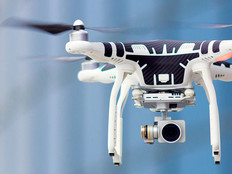Tech Trends for Small Business
What are the technology trends small and medium-sized businesses will need to adopt?
While such businesses will be dealing with a continuation of long-standing trends in the IT world, technologies may emerge or mature rapidly this year.
Some topics are not going away. Cybersecurity remains a perennial concern, but the nature of security is changing as different threat vectors emerge, especially the Internet of Things. Cloud adoption is likely going to continue to and become more pervasive. Artificial intelligence will creep into more facets of business, especially in the form of chatbots. Businesses will need comprehensive mobile solutions, which will include accepting mobile payments. And collaboration tools will continue to evolve as more options spring up.
SIGN UP: Get more news from the BizTech newsletter in your inbox every two weeks!
Here is a quick primer on the key technologies to watch:
IoT Security Remains a Hot Topic
IoT security is now on everyone’s radar in a way it wasn’t even six months ago, making it a clear winner for our technology trends list. As SMBs bring more connected devices into their offices and stores (think thermostats, surveillance cameras, displays, locks and alarm systems, lighting systems, and so on), concerns about their security will grow.
Malware like Mirai, which can infect poorly secured connected devices and then turn them into botnets, can carry out distributed denial of service attacks, as happened in October with the domain name system provider Dyn.
According to the “2017 Study on Mobile and IoT Application Security,” a survey of 593 IT and security practitioners conducted by the Ponemon Institute and sponsored by IBM and Arxan Technologies, insecure IoT devices are viewed as a real threat.
According to the survey, 58 % of respondents say they are concerned about their organization getting hacked via IoT devices, but 44 percent said their organization is doing nothing to prevent these types of attacks; an additional 11 percent said they were unsure if their employer was taking action or not.
“IoT is still fairly new and due to the lack of a big visible hack or a regulation, organizations have a hard time justifying security initiatives,” Mandeep Khera, Arxan’s chief marketing officer, told SC Media. “However, a hack is coming, and in some segments like connected medical and connected automobiles, companies are starting to make good progress in terms of security.”
In November, the National Institute of Standards and Technology issued wide-ranging but voluntary guidance designed to enhance security in IoT devices by building safeguards into them at a systems-engineering level before they reach the market.
Brad Bussie, director of product management for data security software company STEALTHbits Technologies, told SC Media that “until manufacturers stand up and make this a priority and a marketable feature, the industry will continue to produce insecure products regardless of the impact it has on consumers.”
Cloud Computing Becomes the Norm
According to IDC’s 2016 “State of the SMB Cloud” report, in the last five years SMB cloud adoption nationwide has gone from under 20 percent of firms to more than 70 percent for small companies (fewer than 100 employees) and more than 90 percent for midmarket firms (100-999 employees).
What’s driving adoption? According to IDC, some factors include a desire for cloud storage services, including cloud-based back-up and archiving; the continued presence of employee-owned mobile devices; and the adoption of mobile email and basic collaborative apps like Microsoft Office 365.
As SMBs get more comfortable with putting their data in the public cloud (or choose to adopt hybrid cloud solutions), they will likely keep adopting more cloud services. According to the online IT community Spiceworks, IT professionals expect to deploy a slightly larger number of cloud-based services, and 38 percent of IT pros consider it very or extremely important to their current business practices (compared to 29 percent last year). Email hosting, online backup and recovery, web hosting and productivity solutions are expected to be the top cloud services, according to Spiceworks.
Artificial Intelligence Comes Alive via the Chatbot
While small and medium-sized businesses are less likely to adopt AI solutions on a massive scale, especially compared to larger enterprises, AI could start to seep into SMB workplaces in the form of intelligent chatbots that can interact with customers online or via mobile devices.
“Companies large and small are beginning to latch on to the power of chatbots for customer service and other uses, such as finding products, providing shipping notifications, pinpointing business locations and more,” Small Business Trends notes.
Jeff Pulver, a co-founder of Vonage and considered a Voice over IP pioneer, wrote in a blog post that this will be the year of the chatbot and that it will be the “new interface for business to business, business to consumer, and consumer to business communications.”
Additionally, Small Business Trends notes that “technologies like Microsoft’s Bot Framework let companies build and connect bots to interact with users not only on Facebook Messenger but also on websites, text/SMS, Skype, Office 365 mail, Teams and other services.”
Mobile Payment Apps Becomes the Latest Piece of the Puzzle
In addition to the need for mobile-friendly websites, applications and use of all-in-one devices like Microsoft’s Surface Pro, the use of mobile payments is on the rise, Small Business Trends notes.
Mobile payment services, including Apple Pay, Android Pay and Samsung Pay, are becoming more common and widely understood by both consumers and SMBs that take in-store payments.
Such “proximity” payment technologies use near-field communication, which lets users wirelessly pay for goods and services by presenting their phones to NFC readers.
Some services, like Android Pay, also layer on other technologies, such as host card emulation, for increased security. HCE basically stores and transmits payment card information, such as the cardholder’s name and the card number, via the cloud. That way, the information can be accessed and transferred securely by merchants and mobile apps that access the cloud.
According to research firm Javelin Strategy, mobile proximity payment volume has tripled since 2013 — it reached a staggering $10 billion in 2015 — and is expected to increase to $92 billion by 2019.
All-in-one solutions are also coming to SMBs, especially retailers. Samsung recently partnered with Total Merchant Services, which processes payments for small businesses, on the Groovv POS Flex point-of-sale system, designed for small and medium-sized retailers. The system features a Samsung Galaxy Tab E 9.6-inch tablet and an EMV-compliant and NFC-enabled payment processing device, which are preprogrammed with a full suite of software for inventory management, reporting and integrated marketing.
Collaboration Tools Evolve
While email is still a dominant form of workplace communication, usage of collaboration tools such as Google Hangouts, Slack, and Skype for Business are clearly on the rise, with 42% of companies of all sizes currently taking advantage of them and more looking to adopt them in the future, according to a recent survey from Spiceworks.
Currently, Skype for Business is the most widely-adopted app, followed by Google Hangouts and Slack. However, Microsoft Teams, which was unveiled in late 2016, is expected to see the most growth in the next two years, according to the survey. If adoption plans hold true, Microsoft Teams will be the second most commonly-used messaging service in the workplace by the end of 2018, surpassing Slack and Google Hangouts. Other options in the real-time group collaboration market include Facebook Workplace and Spark by Cisco Systems.
These tools will be especially helpful for SMBs with remote workforces and teams that need to chat, send documents and collaborate in real time.








